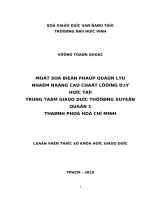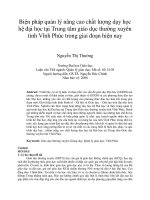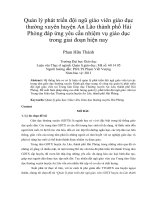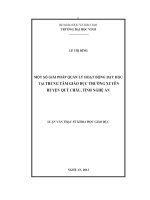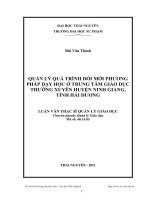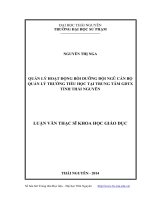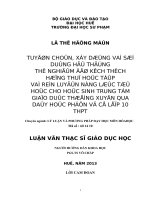Nghiên cứu thái độ học môn ngữ pháp tiếng Anh của học sinh Trung tâm Giáo dục Thường xuyên Quận Đồ Sơn, thành phố Hải Phòng
Bạn đang xem bản rút gọn của tài liệu. Xem và tải ngay bản đầy đủ của tài liệu tại đây (579.42 KB, 60 trang )
VIETNAM NATIONAL UNIVERSITY – HANOI
COLLEGE OF LANGUAGES AND INTERNATIONAL STUDIES
FACULTY OF POST – GRADUATE STUDIES
KHUC HAI YEN
STUDENTS’ ATTITUDES TOWARDS ENGLISH GRAMMAR
LEARNING: THE CASE OF DO SON CONTINUING
EDUCATION CENTRE, HAI PHONG CITY
NGHIÊN CỨU THÁI ĐỘ HỌC MÔN NGỮ PHÁP TIẾNG ANH
CỦA HỌC SINH TRUNG TÂM GIÁO DỤC THƯỜNG XUYÊN
QUẬN ĐỒ SƠN, THÀNH PHỐ HẢI PHÒNG
Minor Programme Thesis
Field: English Teaching Methodology
Code: 60 14 10
Supervisor: Khoa Anh Viet, M.A
Hanoi, September, 2010
iv
TABLE OF CONTENTS
DECLARATION i
ACKNOWLEDGEMENTS ii
ABSTRACT iii
TABLE OF CONTENTS iv
TABLE OF FIGURES vi
PART A: INTRODUCTION 1
1. Rationale 1
2. Aims of study 2
3. Research questions 3
4. Scope of study 3
5. The setting and background 3
6. Organization of the study 3
PART B: DEVELOPMENT
CHAPTER ONE: LITERATURE REVIEW 5
1.1 Attitudes 5
1.1.1 Definition of attitude 5
1.1.2 The role of attitudes in language learning 6
1.2 Grammar 6
1.2.1 Definition of grammar 6
1.2.2 The role of grammar in language learning 12
CHAPTERTWO: RESEARCH METHODOLOGY 16
2.1 Methodology 16
2.2 Research questions 16
2.3 Participants 16
2.4 Data collection instruments 16
CHAPTER THREE: DATA ANALYSIS AND DISCUSSION…………………………20
3.1 Data analysis and discussion 19
3.1.1 Data analysis of students‟ questionnaires 19
3.1.2 Data analysis of students‟ interviews 32
v
3.2 Discussion 34
3.3 Conclusion 35
PART C: RECOMMENDATION AND CONCLUSION 36
1. Summary of the findings 36
2. Suggestions 37
2.1 For students 37
2.2 For teachers 37
3. Limitations of the study and suggestions for further studies 39
3.1 Limitations of the study 39
3.2 Suggestions for further studies 39
4. Conclusion 40
REFERENCES 42
APPENDIX 1 I
APPENDIX 2 VI
PHIẾU ĐIỀU TRA NGHIÊN CỨU VI
APPENDIX 3 XI
INTERVIEW TRANSCRIPTS XI
vi
LIST OF FIGURES
Figure 1. Students‟ interest in learning English 19
Figure 2. Good grammar for purpose of being proficient in English 21
Figure 3. Necessary of English grammar in language learning 22
Figure 4. The reasons why English grammar is important in language learning 23
Figure 5. The frequency of expressing idea in correct grammar structure in communication
24
Figure 6. Students‟ favourite lesson of English in the class 25
Figure 7. Students‟ feeling about lessons of English grammar in the class 26
Figure 8. Students‟ attention to English grammar learning lesson 27
Figure 9. Students‟ level of understanding of teacher‟s grammatical explanation 27
Figure 10. Students‟ opinion about the difficulty of English grammar 28
Figure 11. Teaching techniques to explain new English grammar structures 29
Figure 12. Students‟ opinion about teaching techniques to explain new English grammar
structures 30
Figure 13. Students‟ opinion about factors may influence their attitudes towards grammar
learning 31
1
CHAPTER ONE: INTRODUCTION
1.1 Rationale
It is said that nowadays foreign languages and informatics are wings to fly in to the
new century. Learning foreign language do not only focus on four skills of language –
reading, writing, speaking, and listening but grammar as language rules are also
concentrated. During the time I studied in secondary school and studied teaching of
English in university, English as school subject that I have had to across different theories
about grammar. Some of the theoreticians suggest that grammar teaching and learning can
be put aside in favour of lexical approach (Lewis 1993: 148), others, however, point out
that grammar needs to be taught and concentrate on various ways of approaching grammar
teaching. I remember that an Australian Philosopher, Ludwig Wittgenstein 1889-1952
stated “Like everything metaphysical the harmony between thought and reality is to be
found in grammar of language”. The nature of grammar determines that grammar teaching
is necessary. Without a firm knowledge of grammar in the target language, learners cannot
produce meaningful sentences. They risk being misunderstood and making crucial
mistakes in communication both oral and written. This is especially true when the mother
tongue and the target language are significantly different in grammar and structures. Since
it is, in effect, the glue that holds the language together. With the use of incorrect grammar
structures, sentences can become meaningless and their message is unclear. This means
that you are not able to communicate effectively and the person who is reading your work
may well be quite confused as to your meaning. In effect, grammar is the way in which
sentences are structured and the language is formatted, so whilst it may be considered a bit
boring to study correct grammar, it really is worth the time and effort. If you do not know
the rules of grammar, then you will never be able to communicate clearly and effectively in
a language. Many researches show that with students, grammar has always been playing a
role: it is very important in that not only does it help improve learners writing, but
also it helps learners do better in reading comprehension and listening alike.
Students, with good grammar mastery, not only produce sentences grammatically but also
2
acquire the ability to apply grammatical knowledge in certain contexts to express their
thoughts and feelings as well as to receive feedback.
Grammar is very important in language learning and teaching. In Vietnam, foreign
languages teaching in general and English teaching in particular is said grammar-focused,
and for many teachers of English, teaching English means teaching grammar. Or grammar
is central to the teaching and learning of language.
However, the fact that makes me and many others surprised is the ability of
speaking English of children to foreigners around these famous resorts where attract a lot
of foreign tourist as Hoan Kiem Lake in Hanoi capital, Do Son beach, Sam Son beach,
etc They speak English very fast but without any grammar rules. They call foreigners for
buying things, speak to them, take them to somewhere, etc to get money. They speak in
slang, word-by-word, incomplete sentences, even use body language. And, surprisingly,
foreigners understand almost what they mean. Students in Do Son Continuing Education
Centre are the same. They live near Do Son beach, they have to earn money out of school
time to help their family everyday, and they have many chances to communicate with
foreigners.
This fact lets me think that if they study English grammar in the school well, they
will surely speak English both smoothly and sensitively with full sentences. If so, they
might not be only sellers around these tourist areas, they will get more success in their job
and in their future.
That is the reason why I decide to investigate students‟ attitudes towards English
grammar learning, the case of Do Son Continuing Education Centre, Hai Phong City
1.2 Aims of study
With the above-presented rationale, the study aims at:
Investigating into students‟ attitudes towards English grammar learning in Do Son
Continuing Education Centre.
Finding out some suggestions that good for both teachers and students in English
grammar teaching and learning, particularly in Do Son Continuing Education
Centre.
3
1.3 Research questions
1. What are attitudes of students in Do Son Continuing Education Centre towards
English grammar learning?
2. Why do they have those attitudes towards English grammar learning?
1.4 Scope of study
As it has been stated above, the study is designed to explore students‟ attitudes
towards English grammar learning. Due to the time limit, it is restricted to the students in
Do Son Continuing Education Centre.
1.5 The setting and background
Do Son Continuing Education Centre is located in Do Son district of Hai Phong
City, a major sea port of Vietnam. It is near Do Son beach, a famous resort of Hai Phong
City and Vietnam. Do Son Continuing Education Centre is not a big one, far from the city
centre, so, there are three grades with only three classes: 10A, 11B, 12C. It has low-
income- quality. Students failed the examination into upper secondary schools, then, they
came here to study. English now is taught as an option subject in every Continuing
Education Centers because they do not have to pass this subject in the national
examination administered by the end of grade 12
th
to be qualified for the secondary school
diploma as students in secondary schools. Both textbook and the syllabus for English are
prescribed by the Ministry of Education and Training, and students have three forty-five-
minute lesson of English a week. However, most students in Do Son Continuing
Education Centre come from poor-labour families, many of them have to both go to
school and go to work at the beach to help their families. Every year, Do Son beach
attracts a lot of foreign tourists, so students here want to learn English to communicate
with them to earn money.
1.6 Organization of the study
The thesis contains four chapters:
Chapter one: Introduction
Chapter two: Literature review
4
Chapter three: The study
Chapter four: Recommendation and conclusion
Chapter one provides all information about the rationale, the aims, the research
questions, the scope of study, the setting and background, and the organization of the
minor thesis.
Chapter two is aimed at exploring the theoretical background for the thesis. It will
focus on two main points: attitudes and grammar.
Chapter three presents the methodology with the research questions, the
participants, the data collection instruments, the detailed description of data analysis and
discussion on the findings of the study.
The last chapter, chapter four, presents a summary of the findings and draws out
some pedagogical suggestions that good for both teachers and students in teaching and
learning English grammar. The limitations of the study and some recommendations for the
further researches are also discussed in this chapter.
5
CHAPTER TWO: LITERATURE REVIEW
This focuses on some theoretical grounds of attitude and grammar teaching and
learning. It is concerned with major issues regarding attitudes, the roles of attitudes in
language learning and grammar, the role of grammar in language learning
2.1. Attitudes
2.1.1 Definition of attitude
According to Hallorah (1967), attitude represents an individual‟s like or dislike for an
item. Attitudes are positive, negative or neutral views of an “attitude object” i.e. a teaching
style, person, situation or event. People can also be “ambivalent” towards a target, meaning
that they simultaneously possess a positive and a negative bias towards the attitude in
question.
In Gibb‟s opinion (1988) attitude is generally defined as a state of mind, which is
influenced by feelings, experiences of the world and belief.
Fazio (1986) states that attitude comprises of three components: “an affective
component involving feelings about and evaluation of the object, a cognitive component
involving belief about the object and a behavioral intentions component”.
The above definition show people‟s attitude towards certain referent object, a
behavioral intentions component and a cognitive component involving belief about the
object. In language learning, we can see students‟ attitudes in their feelings and belief
about the way of acting towards the lessons, learning style, teachers and the course books.
Briefly, attitudes have three main components: affective, behavioral and cognitive.
The affective components are easily assessed by monitoring physiological signs such as
heart rate whereas the behavioral aspects of attitude are generally measured by interviews,
survey and other reporting methods. This study concentrates on affective and cognitive
components. It relates to students‟ feeling and belief about communicative teaching as well
as evaluation of grammar learning.
6
2.1.2 The role of attitudes in language learning
Attitudes and learning go hand in hand. Garder and Lamber (1972) all agree that
“success in mastering a foreign language would depend not only on intellectual capacity
and language aptitude, but on one‟s attitudes towards representatives of that language as
well”. In fact, attitudes play an important role student „learning. If they maintain a positive
attitude, they will carry out their learning to the best of their ability and vice versa.
Students‟ attitudes have an effect on their classroom behavior, learning style and learning
results.
Lightbrown and Spada (1999) state that attitude is fundamental to the success or
failure that we experience in learning. Depending on the learners‟ attitudes, learning
language can be a source of enrichment or a source of resentment. Agreeing with the role
of attitudes, Brown (1994) say that language learners‟ benefit from positive attitudes while
negative attitudes may lead to unsuccessful attainment of proficiency. Moreover, Garder
(1985:41) emphasized that favorable attitudes would be expected to result in better
performance than negative attitudes. If the students hold positive attitudes to learning,
Marzano et all (1994) mentioned the importance of positive attitudes in learning that
“without positive attitudes and perceptions or holding negative attitudes towards the
learning, students have little chance of learning proficiently, if at all”.
In brief , it is clear that attitudes play an important role in learning so students will
see themselves achieving greater and greater result in language learning in general and in
grammar learning in particular whereas negative attitudes will hinder their learning.
2.2 Grammar
2.2.1 Definition of grammar
Different linguistic schools define grammar in different ways depending on their particular
field of interest:
A traditional grammarian might see grammar as the “part of speech”
together with a set of rules governing how they can be combined, often accompanied by
pointers as to what is considered “correct” and “incorrect” usage.
7
A structural linguist might see grammar as the sum total of sentence patterns
in which the words of a particular language are arranged.
Philosophical/cognitive linguist might see grammar as our innate
knowledge of the structure of language.
A functional linguist might see grammar as a resource use to accomplish
communicative purpose in specific contexts.
Defining grammar, then, is not a straightforward matter and it is important to clarify how
the term is being used in any particular context. For my purpose in this study, I will look at
five definitions that I think might be more relevant to this study.
The Long dictionary of contemporary English (as cited in Harmer, 1987:1) defines
grammar as “the study and practice of the rules by which words change their forms and are
combined into sentences”
It is obvious that there are two basic elements to which attention should be paid to:
the rules of grammar; and the study and practice of the rule.
According to Fromkin (1990:12): “The sounds and sound patterns, the basic units of
meaning such as words and the rules to combine them to them to from new sentences
constitute the grammar of a language. These rules are internalized and subconsciously
learned by native speakers.”
From this definition, grammar is the name given to the knowledge of how words
are arranged to from sentences. The definition also clarifies that grammatical riles is
learned in a natural way by native speakers, but how non-native speakers learn the
grammar of their language other than their mother tongue? In addition, if grammar
constitutes rules to combine words to make sentences, what are the sentences used for?
These questions need to be elaborated.
Another scholar, Bastone (1994) divides grammar into product: the component
parts or rules that make up the language, and process: the ways in which grammar is
deployed from moment in communication. Bastone (ibdi) purports that while of no doubt
the rules are important to the leaner, simply knowing them is by no means a guarantee of
being able to formulate or interpret complicated utterances in the rush real-time
communication. Obviously, Batone takes a more sociolinguistic view of grammar, which
8
views grammar is not just rules, but more importantly, rules of use. This means that “There
are rules of use without which the rules of grammar would be useless.” (Hymes, 1972:45).
Richards, Platt and Platt (1992:161) in their Longman Dictionary of Language Teaching &
Applied Linguistics, define grammar as:
“a description of the structure of language and the way in which linguistic units such as words and phrases
are combined to produce sentences in the language. It usually takes into account the meanings and functions
these sentences have in the sounds of language”.
For Richards and his colleagues, grammar is descriptive, rather than prescriptive
and it implies both meanings and functions. Their view of grammar reflects, firstly, the
dynamics of language, and secondly, the social and personal nature of language. Grammar
is the way people of a particular language community use to get meanings across, not the
way people are prescribed to use the language.
All the three definitions view grammar as meaning, but they share a common
drawback, which confine grammar to just sentences. Widdowson (1990:81) claimed that
“Grammar is not just a collection of sentence patterns signifying nonsense, something for
the learner‟s brain to puzzle over.” For Widdowson, Grammar means the relationship
between three things: grammar, words and context. In other words grammar should be
viewed as linguistic rules functioning in alliance with words and context for the
achievement of meaning.
Hughes and McCarthy (1998) view grammar as discourse not as sentence and
coined the term discourse grammar. They argued that “grammatical statements that do not
take account of such contextual features are inadequate and unable to support grammar
teaching effectively” (p.265).
How grammar is defined is very important sine it will influence the way grammar
is to be taught. For the purpose of the study, I use the definition of grammar proposed
above by Richards, Platt and Platt (1992:161) in their Longman Dictionary of Language
Teaching & Applied Linguistics.
2.2.1.1 Grammar as rules
According to Longman Active study’s Dictionary, “rule” is defined as:
- a principle or order which guides behaviour, says how things are to be done, etc, or
9
- the usual way that something happens.
With regard to grammar, the first type of rule is often called a prescriptive rule and
the second a descriptive rule. For many people, grammar teaching is traditionally
associated with the teaching of the first type of rules – that is, prescriptions as to what
should be said or written. On the other hand, there are language teachers who are primarily
concerned with descriptive rules that are with generalizations about what speakers of the
language actually do say rather than with what they should do.
Thornbury (1999:11) observes that “Until recently most so-called descriptive rules
were based on hunches and intuitions. There is much greater authority in descriptions of
language since the advent of large computer databases of naturally occurring language,
known as corpora”. (Original emphasis)
With regard to rules, Thornbury (ibid.) coins the third category of rule: pedagogic
rules – rules that make sense to learners while at the same time providing them with the
means and confidence to generate language with a reasonable chance os success. Within
pedagogic rules, Thornbury makes a distinction between rules os form and rules os use.
The former are generally easier to formulate and are less controversial while the latter are
heavily dependent on contextual factors, and therefore are seldom captured in terms that
are black and white.
Thus, from the teaching point of view, Thornbury (ibid:13) advised that we should
look at “ways that grammar rules can be formulated, according to whether they are
prescriptive, descriptive or pedagogic, and whether they focus on form or on use”.
2.2.1.2 Grammar as meaning
Bolinger (as cited in Hedge 2000:153) claims that:
Linguistic meaning covers a great deal more than reports of events in the
real world. It expresses our attitudes towards the person we are speaking to, how we feel
about the reliability of our message, how we situate ourselves in the events we report, and
many other things that make our messages not merely a recital of facts but a complex of
facts and comments.
Examples of grammar as meaning are:
10
1. I must get in touch with my mother this week.
2. I have to complete this report by tomorrow.
3. I ought to phone John today.
4. I‟d better complete this report by Friday.
(Hedge 2000:153)
These examples illustrate how speakers situate themselves in the events they report.
The meanings of these sentences will be changed if the first person is replaced by the third
person. Also, intonation, when combined with grammar, will play a role of expressing the
speaker‟s attitudes or intentions. According to the grammar-as-meaning view, grammar is
a “process for making a speaker‟s or writer‟s meaning clear when contextual information is
lacking” (Thornbury, 1999:4). Learners, therefore, need to learn not only what forms are
possible, but what particular forms will express their particular meanings. Seen from this
perspective, grammar is a tool for making meaning (Thornburry, ibid.).
A view of grammar as meaning will influence the ways in which grammatical
forms are presented as expressing concepts such as obligation in the examples above.
Teaching grammar means drawing the learners‟ attention not only on the forms of the
language, but on the meanings these forms convey as well.
2.2.1.3 Grammar as social function
In the mid-seventies the relation between grammar and function became an
important issue for teachers. Writers of language teaching materials attempted to move the
emphasis away from the learning of grammatical structures independent of their use, and
on to learning how to function in a language, how to communicate. An example of
grammar used in the service of socially appropriate messages, according to Celce-Murcia
(1991:67) “is the use of certain modal auxiliaries to express politeness when one is
requesting a favour”. For example would is more polite than will and could is more polite
than can in the following examples:
Will/Would you open the door?
Can/ Could I talk to you for a minute?
11
Leech and Svartvik (1975:11) maintain that
“Where English gives us a choice of grammatical structures for a partocular
purpose, the different grammatical structures available are often not equivalent, since they
belong to different „styles‟ or „varieties‟. We believe that the appropriate choice is as
important as it is difficult”.
They gave the following examples to demonstrate that the same message can be
conveyed in different manners:
I suppose he‟s quite a nice little boy, isn‟t he? (tentative, polite)
Nice kid. (informal, spoken)
In all, he was a pleasant child. (formal, written)
A cheerful child of pleasant disposition. (literary)
One of the ways in which an understanding of the structure and use of the language
system can help teachers, according to Hedge (2000:158) “is in providing insights for
contextualizing grammar when it is offered to students in spoken or written texts”. Thus,
teaching grammar out of context is likely to lead to misunderstandings. For example,
whether Do you drink? Means Would you like a drink? Or something else can be
understood only in the context.
2.2.1.4 Grammar as discourse
In their book A Communicative Grammar of English, Leech and Svartvik (1975)
devote one section to „Meanings in connected discourse‟ and look at how meanings can be
put together in spoken or written discourse:
“…the consideration of use requires us to go beyond the sentence and to
look at larger stretches of language. Normal linguistic behaviour does not consist in the
production of separate sentences but in the use of sentences for the creation of
discourse.”(original emphasis) (Widdowson 1978:22)
Rules, therefore, might be seen to operate across the boundaries of sentences as
well as within them. Learners should learn how sentences can be combined in written texts
and how utterances link in speech. Halliday and Hasan (as cited in Celce- Murcia, 1991)
12
refer to these features of text structure as cohesion. According to them, cohesion involves
the principled use of (a) referential forms (e.g. pronouns, demonstratives, the definite
article); (b) substitute expressions such as one(s), do, and so; (c) ellipsis; (d) conjunction;
and (e) lexical chaining to create texture in discourse. Leech and Svartvik (1975) present
six ways of organizing connections: (1) linking signals; (2) linking constructions; (3)
general purpose links; (4) substitution and omission; (5) presenting and focusing
information; and (6) order and emphasis.
2.2.2 The role of grammar in language learning
In the 1970s, the necessity of formal grammar learning met almost no
disagreement. It was a common place that a major portion of curriculum was devoted to
learning grammatical terminology, memorizing rules doing exercises, practicing drills or
so on. However, many different and even contradictory views emerged during the latter
half of the twentieth century. These different attitudes toward the role of grammar in ELT
stem mainly from different views about language and language learning process. Below, I
will examine several arguments for and against grammar.
2.2.2.1 Pro-grammar perspectives.
Many linguists and researchers have advocated grammar instruction in ESL and
EFL language teaching and learning. For instance, the communicative competence model
of Canale and Swain (1980) clearly illustrates the significance of grammar. In this model
grammar is seen as one component of communicative competence. Without grammar,
learners can communicate effectively only in limited number of situations. Referring to the
importance of grammar teaching, Smith (2001) worries that if we do not pay attention to
grammar nor create opportunities for learners to improve their grammar, they are likely to
stand the risk of fossilization ”or reach a point where they can cope with level of
communication that is demanded of them by making use of their existing grammatical
resources and communication strategies and probably with sufficient fluency not to see the
need to develop their linguistic abilities any further.‟
What is more, Rutherford and Smith (1988) report that grammar teaching can be
beneficial to learners consciousness concerning the difference and similarities of L1 and
13
L2. Therefore, grammar teaching can be used as a “linguistic map” with road signs to help
students as they explore the “topography” of the new language.
The list of supporters of grammar is still ongoing. Hannan (1989) argues that
grammar is highly valuable as an important part of the study of language, of ideas and of
writing. Also, he points out that grammar reflects the power and order of the human mind
and, besides, it helps us to understand the diversity of human culture. Like Hanman, Lewis
(1986), Garner (1989) gives strong support to grammar teaching. Garner believes that
grammar gives us a means to analyze and describe our language. To sum up, the rationale
for teaching grammar is multifaceted and grammar is acknowledged to be of importance in
language study in general and in language teaching and learning in particular.
2.2.2.2 Anti-grammar perspectives
One of the biggest challenges to the necessity of grammar teaching comes primarily
from Krashen, whose insistence on the primacy of acquisition has tended to downplay the
value of deliberate grammar teaching. In Krashen and Tarrel‟s influential Natural
Approach it is claimed that learners need to be exposed to lot of comprehensive and
meaningful input at a level just above their own for acquisition to take place. The study of
grammar has only a secondary role in the language programmer with goal to produce
optimal monitor-user, programmers who can use grammar as a supplement to acquisition
when they have time, when the focus is on from, and when they know the rules (the
Monitor Hypothesis) (Krashen and Tarrel:1983)
Fanatics of the Natural Approach argue that reliance on grammatical syllabus, no
matter how contextualized it is, cannot be sufficient, that a grammatical focus may
interfere with any attempt to communicate. It thus appears to be the case that “we not only
don‟t have to use a grammatical syllabus in encouraging acquisition, it is better not to even
try” (ibid: 72). Put another way, grammar can be acquired naturally, from meaningful input
and opportunities to interact in the classroom and grammatical competence can develop in
a fluency-oriented environment without conscious focus on language forms.
Admittedly, some learners acquire second language grammar naturally without
being taught. Immigrants to the United States (especially young ones) who attain
proficiency in English on their own can be a good example of naturalistic acquisition
14
(Lightbown and Spada, 1999:60). However, this is not true for all learners. Among the
same immigrant group are learners who may achieve a degree of proficiency, but whose
English is far from accurate.
On the other hand, Krashen‟s acquisition hypothesis seems to be merely his own
personal observation without supporting evidence. Gregg (1984:79-100) criticizes
that:”Krashen himself seems to be aware of this: The idea that we first learn a new rule,
and eventually, through practice, acquire it, is widespread and many seem to some people
to be intuitively…It was, thought, exactly the way I learned languages myself…” Thus
Gregg sees himself as a typical example of the process which consists of knowing the
rules, being aware of them and ending up with an ability to talk about them. This is a
perfect process of acquiring though learning, opposed to Krashen‟s claim that learning
need not precede acquisition. Furthermore, studies of learns in immersion classroom (e.g.
Swain, 1985) show even after ample exposure to the target language learners continue to
make a lot of grammatical errors.
With regard to the value of form-focus, teaching two important questions may
arise. The first is whether it is possible with teaching to assist learners who cannot achieve
accuracy in English by themselves and the second is it possible to speed up students‟
natural learning of grammar though instruction. A number of research findings (Schwabe,
1989, Larsen-Freeman, 1995 and) prove that teaching assists to improve learners‟
accuracy, which is normally absent when there is no focus on form. As far as second
question concerns Pienemann (1984) demonstrates that subjects who received grammar
instruction progressed to the next stage after two-week period while it took untutored
students several months to do that. This provides evidence of the efficacy of teaching over
leaving acquisition to run its natural course.
In order to decide whether the focus on grammatical forms becomes more or less
important, various learner factors such as age, learning styles, proficiency level, purpose of
learning, exposure to the target language, etc… should be taken into consideration. Celce-
Murcia (as cited in Shrum and Glisan:1994) points out that students in upper secondary
schools are already literate and, therefore, have established expectations concerning
language instruction. And, we need to remind ourselves why students come to school. The
answer lies in getting “right knowledge”. Instead of letting, they swim in the ocean of
15
knowledge we should provide them with a “swimming jacket”-formal instruction-to
facilitate their learning. Why should we refuse teaching them grammar?
Next, it is worth mention that Krashen‟s view that the effect of grammar learning is
peripheral and fragile and that conscious knowledge of grammar is available only as a
monitor, or editor may be true to ESL context where immigrant learners are extensively
exposed to the target language but it is not applicable to the EFL context. In a poor-input
setting like in Vietnamese secondary schools, where students learn English as a foreign
language outside the natural linguistic environment, grammar teaching must still have an
important place in the classroom. We cannot expect our students who learn English for
probably not more than three lessons a week to acquire the target grammar naturally
although some students might have access to various sources of authentic English at home.
I stand for Celce-Murcia‟s (1992:406-407) point of view that: “Generally, only young,
prepubescent learners, and then only those with good access to native-speaking peers and
sufficiently rich and varied native speakers input, can in the absence of formal grammar
instruction learn a foreign or second language with native like proficiency and accuracy”.
16
CHAPTER THREE: THE STUDY
3.1 Methodology
3.1.1 Research questions
3.1.1.1 What are attitudes of students in Do Son Continuing Education Centre
towards English grammar learning?
3.1.1.2 Why do they have those attitudes towards English grammar learning?
On the base of research questions and the purpose of the study as presented in the
Chapter one, both qualitative and quantitative methods are employed in order to gain more
in depth data for analysis.
3.1.2 Participants
To cover the title of the study: “Students‟ attitudes towards English grammar
learning: The case of Do Son Continuing Education Centre, Hai Phong City”, this study
was carried out with three classes 10A, 11B, 12C consisting of 150 people, who are all of
students of three grades in this Centre. Each class has 50 students, both male and female.
They are all taught by Vietnamese teachers of English. Many of them come from
comparatively poor families, so their learning condition is not good enough. Their tools are
textbooks only. Most of them go to Do Son beach – a famous tourism area to get money in
the daytime to help their families and go to Centre to study in the nighttime. The reason for
the choice of all students in the Centre is that the number of students here is not big, and, I
would like to have the general view about attitudes of all of students here towards English
grammar learning.
3.1.3 Data collection instruments
To obtain data for the study, two different instruments were employed: survey
questionnaire and follow-up interview.
17
3.1.3.1 Questionnaires
One of the most common methods of data collection in second language research is
to use questionnaires of various kinds. The popularity of questionnaires is due to the fact
that they are easy to construct and uniquely capable of gathering a large amount of
information quickly in a form that is readily process able (Dornyei, 2003:1). A
questionnaire can be composed of both closed questions and open questions. Where the
answer is a factual one and fairly predictable, a closed question is preferred, but where the
answers are in terms of opinions, beliefs or judgments, an open question is better simply
because a small range of predetermined answers is less likely to be representative
(Gillham, 2000:5). Open questions allow the respondents to feel that they can contribute
more individual points of view and more detailed information that is elicited in closed
questions
To sum up, according to Gillham (2000), questionnaire is considered the most
appropriate research instrument for gathering information concerning the attitudes of the
respondents. There are three reasons. Firstly, as the respondents want to remain
anonymous, information from questionnaire can be confidential. It is hope that people will
undoubtedly fell freer in an anonymous style of responding. Secondly, a questionnaire is
easy to administer enabling the researcher to survey a large number of respondents.
Thirdly, the respondents can complete the questionnaire whenever it suits them. Moreover,
this is a confirmatory research study.
In this research, the questionnaire consists of 15 questions, both closed and open-
ended questions which were given to 150 students of class 10A, 11B, 12C of Do So
Continuing Education Centre and respondents were asked to explain their reason(s) for
answering Yes or No or the degree of interest to the question (Appendix 1). All questions
were written in both English and Vietnamese to ensure that students can fully understand
the questions and in order for them to response explicitly, without having difficulties in
expressing their idea.
The questions focus on the following categories:
General attitudes towards learning English (Q1).
Awareness of the importance of grammar (Q2, Q3, Q4, Q5).
18
Students‟ attitudes towards English grammar learning (Q6, Q7, Q8, Q9).
Students‟ impression on English grammar teaching at the Centre (Q10, Q11,Q12).
3.1.3.2 Interviews
An interview is a conversation between two or more people (the interviewer and
the interviewee) where questions are asked by the interviewer to obtain information from
the interviewee.
Interviews may be used as the primary research tool or in an ancillary role as a
checking mechanism to triangulate data gathered from other sources. Hopkins (cited in
McDonough & McDonough (1997:181) lists three applications of interviews in classroom
research:
To focus on a specific aspect of classroom life in detail
Teacher-pupil discussion -> diagnostic information
To improve the classroom climate
Nunan (1992) adds the following uses to interviews:
needs analysis
program evaluation
individual case studies
mini-surveys (within institution)
In this study, fifteen students among the questionnaire respondents were chosen
randomly for a follow-up interview for more in-depth data. The interview was a structure
one in which the “agenda is totally predermined order (Nunan, 1992:149). According to
Nunan (ibid.) “the type of interview one chooses will be determined by the nature of the
research and the degree on control the interviewer wishes to exert”. This study was aimed
at finding out the students‟ attitudes towards grammar and the reason why they have those
attitudes. It is not of naturalistic inquiry by nature, therefore I choose the structured
interview in order to achieve consistence. Each of the interviewees was asked five
questions (Appendix 3). Since the purpose of the interview was to have more in-depth
19
information, I decided to interview a group selected randomly from the questionnaire
respondents (each group consists of five students of grade 10
th
, five students of grade 11
th
,
and five students of grade 12th)
3.2 Data analysis and discussion
3.2.1 Data analysis of students’ questionnaires
3.2.1.1 General attitudes towards learning English (Q1)
15.10%
51.90%
24.65%
9.35%
0.00%
10.00%
20.00%
30.00%
40.00%
50.00%
60.00%
very
interested
interested neither
like nor
dislike
not
interested
Figure 1. Students’ interest in learning English
Source: Question 1
In the questionnaire, followed by the first question asking students about their
attitudes towards learning this subject (See appendix 1). As can be seen in the figure 1,
remarkably, more than half of the participants (51.90 %) expressed that they like learning
20
English grammar; 15.1% of students say that: “English is so great” so, they like it very
much.
With regard to respondents‟ positive attitudes towards learning English, some
students shared truthfully the reasons, including:
- “I want to communicate with foreigners. It is my tool to get money every day at the
Do Son beach by selling cake, chewing gum, hat, etc to help family. So, I like it”.
- “Thanks to it, I can read foreign books, newspaper and information through internet
in order to discover the life of people all over the world”.
- “We want to watch and understand the famous foreign films in which have our
idols. They are so handsome”, a female students said truthfully with a bit
embarrassed.
- “I want to go abroad to change my life”.
- “I love it. It is an international or common language in the world and knowing this
language is necessary for my future”.
Whereas, only 9.35% of students have opposite ideas with that point of view. They
felt that they spent too much time on learning boring unpleasant and difficult things. And
some students mention the overload of learning at school as a reason when they state:
- “I will be interested in learning English only when there are not any other subjects
to study at school”.
- “English lessons are boring, I always feel asleep during the lessons” or “I did not
comprehend the teachers saying and explanations” or even
- “Teacher‟s performance and explanation is awful”.
Some students thought that English is such a complicated subject that they believed
their IQ is not high enough to learn English so they hate this subject.
However, 24.65% of students express their neutral attitudes that they neither like
nor hate English because they find nothing interesting in learning this subject. Some
students say that they are aware of the benefit of learning English but it is hard to acquire
because: “There are too many new words in a lesson and I don‟t know how to pronounce
21
and how to use them appropriately.” or “Sometimes learning English is a great favourite of
mine and I am aware that knowing English is an advantage for my future, but I don‟t know
how to learn it effectively”.
3.2.1.2 Awareness of the importance of grammar (Q2, Q3, Q4, Q5)
Yes
67%
No
33%
Figure 2. Good grammar for purpose of being proficient in English
Source: Question 2
As can be seen in the Figure 2, a bigger number of students (67%) agree that good
English grammar make us using English skillfully. 37% of students disagree with this idea.
Explain to this question, the reasons for the necessity of mastering English
grammar were varied but the following are common among the respondents:
- “Master of English grammar is a key to successful communication”.
- “Knowing grammatical rules students can produce correct sentences. If a student
doesn‟t know the rules, how can he make up correct sentences?”
- “Master of English structures enables one to become understood when speaking
and writing”

